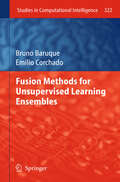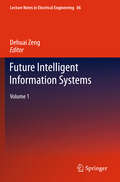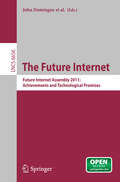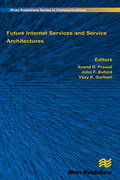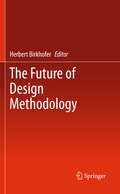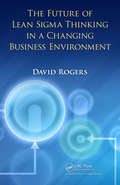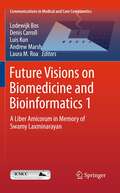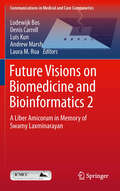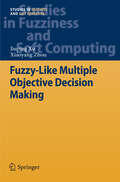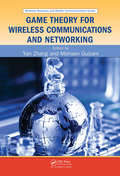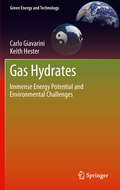- Table View
- List View
Fusion Methods for Unsupervised Learning Ensembles (Studies in Computational Intelligence #322)
by Bruno BaruqueThe application of a “committee of experts” or ensemble learning to artificial neural networks that apply unsupervised learning techniques is widely considered to enhance the effectiveness of such networks greatly. This book examines the potential of the ensemble meta-algorithm by describing and testing a technique based on the combination of ensembles and statistical PCA that is able to determine the presence of outliers in high-dimensional data sets and to minimize outlier effects in the final results. Its central contribution concerns an algorithm for the ensemble fusion of topology-preserving maps, referred to as Weighted Voting Superposition (WeVoS), which has been devised to improve data exploration by 2-D visualization over multi-dimensional data sets. This generic algorithm is applied in combination with several other models taken from the family of topology preserving maps, such as the SOM, ViSOM, SIM and Max-SIM. A range of quality measures for topology preserving maps that are proposed in the literature are used to validate and compare WeVoS with other algorithms. The experimental results demonstrate that, in the majority of cases, the WeVoS algorithm outperforms earlier map-fusion methods and the simpler versions of the algorithm with which it is compared. All the algorithms are tested in different artificial data sets and in several of the most common machine-learning data sets in order to corroborate their theoretical properties. Moreover, a real-life case-study taken from the food industry demonstrates the practical benefits of their application to more complex problems.
Future Intelligent Information Systems: Volume 1 (Lecture Notes in Electrical Engineering #86)
by Dehuai Zheng2010 First International Conference on Electrical and Electronics Engineering was held in Wuhan, China, December 4-5. Future Intelligent Information Systems book contains eighty-five revised and extended research articles written by prominent researchers participating in the conference. Topics covered include Tools and Methods of AI, Knowledge Discovery, Information Management and knowledge sharing, intelligent e-Technology, Information systems governance, and Informatics in Control. Intelligent Information System will offer the state of art of tremendous advances in Intelligent Information System and also serve as an excellent reference work for researchers and graduate students working with/on Intelligent Information System.
The Future Internet: Future Internet Assembly 2011: Achievements and Technological Promises (Lecture Notes in Computer Science #6656)
by John Domingue Alex Galis Anastasius Gavras Theodore Zahariadis Dave Lambert Frances Cleary Petros Daras Srdjan Krco Henning Müller Man-Sze Li Hans Schaffers Volkmar Lotz Federico Alvarez Burkhard Stiller Stamatis Karnouskos Susanna Avessta Michael NilssonIrrespective of whether we use economic or societal metrics, the Internet is one of the most important technical infrastructures in existence today. It will be a catalyst for much of our innovation and prosperity in the future. A competitive Europe will require Internet connectivity and services beyond the capabilities offered by current technologies. Future Internet research is therefore a must. This book is published in full compliance with the Open Access publishing initiative; it is based on the research carried out within the Future Internet Assembly (FIA). It contains a sample of representative results from the recent FIA meetings spanning a broad range of topics, all being of crucial importance for the future Internet. The book includes 32 contributions and has been structured into the following sections, each of which is preceded by a short introduction:Foundations: architectural issues; socio-economic issues; security and trust; and experiments and experimental design. Future Internet Areas: networks, services, and content; and applications.
Future Internet Services and Service Architectures
by Anand R. Prasad John F. Buford Vijay K. GurbaniFuture Internet Services and Service Architectures presents state-of-the-art results in services and service architectures based on designs for the future Internet and related emerging networks. The discussions include technology issues, key services, business models, and security. The work describes important trends and directions. Future Internet Services and Service Architectures is intended to provide readers with a comprehensive reference for the most current developments in the field. It offers broad coverage of important topics with twenty chapters covering both technology and applications written by international experts. The 20 chapters of Future Internet Services and Service Architectures are organized into the following five sections:-• Future Internet Services -- This section contains four chapters which present recent proposals for a new architecture for the Internet, with service delivery in the Future Internet as the key focus.• Peer-to-Peer Services -- Using the P2P network overlay as a service platform, five chapters explore the P2P architecture and its use for streaming services, communication services, and service discovery.• Virtualization -- Virtualization and its benefits for resource management, supporting hetereogeneity, and isolation are the basis for five chapters which describe virtualization at the endpoint, in the cloud, and in the network.• Event-Distribution -- Publish/Subscribe mechanisms are important for applications which require time-sensitive delivery of notifications. The two chapters in this section present recent developments in publish/subscribe load balancing and in sensor networks.• VANETs - Vehicular Ad Hoc Networks (VANETs) are a network technology which are designed for vehicle-to-vehicle and vehicle-to-infrastructure connectivity for moving vehicles. The four chapters in this section provide an introduction to VANETs, routing, services and system architecture.Future Internet Services and Service Architectures is complemented by a separate volume, Advances in Next Generation Services and Service Architectures, which covers emerging services and service architectures, IPTV, context awareness, and security.
Future Internet Services and Service Architectures
Future Internet Services and Service Architectures presents state-of-the-art results in services and service architectures based on designs for the future Internet and related emerging networks. The discussions include technology issues, key services, business models, and security. The work describes important trends and directions. Future Internet Services and Service Architectures is intended to provide readers with a comprehensive reference for the most current developments in the field. It offers broad coverage of important topics with twenty chapters covering both technology and applications written by international experts. The 20 chapters of Future Internet Services and Service Architectures are organized into the following five sections:-• Future Internet Services -- This section contains four chapters which present recent proposals for a new architecture for the Internet, with service delivery in the Future Internet as the key focus.• Peer-to-Peer Services -- Using the P2P network overlay as a service platform, five chapters explore the P2P architecture and its use for streaming services, communication services, and service discovery.• Virtualization -- Virtualization and its benefits for resource management, supporting hetereogeneity, and isolation are the basis for five chapters which describe virtualization at the endpoint, in the cloud, and in the network.• Event-Distribution -- Publish/Subscribe mechanisms are important for applications which require time-sensitive delivery of notifications. The two chapters in this section present recent developments in publish/subscribe load balancing and in sensor networks.• VANETs - Vehicular Ad Hoc Networks (VANETs) are a network technology which are designed for vehicle-to-vehicle and vehicle-to-infrastructure connectivity for moving vehicles. The four chapters in this section provide an introduction to VANETs, routing, services and system architecture.Future Internet Services and Service Architectures is complemented by a separate volume, Advances in Next Generation Services and Service Architectures, which covers emerging services and service architectures, IPTV, context awareness, and security.
The Future of Design Methodology
by Herbert BirkhoferThe Future of Design Methodology gives a holistic overview of perspectives for design methodology, addresses trends for developing a powerful methodical support for design practice and provides a starting point for future design research. The chapters are written by leading scientists from around the world, who have great expertise in design methodology, as well as the farsightedness needed to develop design methodology further.The Future of Design Methodology is a detailed contribution to consolidated design methodology and design research. Instead of articulating the views of one scientist, it provides a comprehensive collection of perspectives and visions. The editor highlights the substantial deficiencies and problems of the current design methodology and summarizes the authors’ findings to draw future-oriented conclusions. The comprehensive overview of the status of design methodology given in The Future of Design Methodology will help enhance the individual scientific development of junior researchers, while the authoritative perspectives on future design methodology will challenge the views of experts. It is suitable for readers working in a wide range of design fields, such as design methodology, engineering design and industrial design.
The Future of Lean Sigma Thinking in a Changing Business Environment
by David RogersOf the 100 companies named to Fortune magazine’s list of the world’s largest companies in 1956, only 29 of those companies remain on that list. Many lost their way because they failed to recognize the changes taking place, or were too big to react quickly enough to shifting market conditions. Supplying Lean practitioners with a formal process for keeping up with technological advancements and shifting business requirements, The Future of Lean Sigma Thinking in a Changing Business Environment provides the tools to survive and prosper through the current business environment. It introduces cutting-edge business solutions from the fields of chemical engineering, aircraft production, and business psychology, and explains how to integrate these concepts with proven Lean principles. The book begins by providing a foundation in essential Lean concepts, including Deming and Juran, Six Sigma, Total Quality Management, the Toyota Production System, and New Six Sigma. Next, it reports on the latest advances in process understanding. By analyzing changing attitudes within the system, it illustrates how new products are being developed using updated Lean thinking. In addition, it provides examples that demonstrate the impact of e-commerce on Lean production systems. Incorporating the green agenda to Lean thinking, the text supplies the insight to safely navigate your company through a shifting business landscape while reducing your impact on raw materials and the environment. By following the principles discussed in this book, you will not only increase your company’s chances of achieving long-term survival but will position your organization to capitalize on the economic upturn on the horizon.
Future Visions on Biomedicine and Bioinformatics 1: A Liber Amicorum in Memory of Swamy Laxminarayan (Communications in Medical and Care Compunetics #1)
by Lodewijk Bos, Denis Carroll, Luis Kun, Andrew Marsh and Laura M. RoaSwamy Laxminarayan was an outstanding researcher active in many diverse fields of science and technology. This liber amicorum in memory of Swamy Laxminarayan collects Medical and Biological Engineering and Informatics contributions to the Safety and Security of Individuals and Society. The authors are renowned scientists and the aim of their writing is to recall the enormous personal and scientific achievement of Swamy Laxminarayan.
Future Visions on Biomedicine and Bioinformatics 2: A Liber Amicorum in Memory of Swamy Laxminarayan (Communications in Medical and Care Compunetics #2)
by Lodewijk Bos, Denis Carroll, Luis Kun, Andrew Marsh and Laura M. RoaSwamy Laxminarayan was an outstanding researcher active in many diverse fields of science and technology. He was one of the most prominent biomedical scientists and his ideas influenced the Biomedical Technology substantially. This book tries to provide an overview on the multiple achievements of Swamy Laxminarayan. It presents a collection of his most outstanding publications and an overview on his outstanding life. This Volume is the second part of the liber amicorum in Memory of Swamy Laxminarayan.
Fuzzy-Like Multiple Objective Decision Making (Studies in Fuzziness and Soft Computing #263)
by Jiuping Xu Xiaoyang ZhouDecision makers usually face multiple, conflicting objectives and the complicated fuzzy-like environments in the real world. What are the fuzzy-like environments? How do we model the multiple objective decision making problems under fuzzy-like environments? How do you deal with these models? In order to answer these questions, this book provides an up-to-date methodology system for fuzzy-like multiple objective decision making, which includes modelling system, model analysis system, algorithm system and application system in structure optimization problem, selection problem, purchasing problem, inventory problem, logistics problem and so on. Researchers, practitioners and students in management science, operations research, information science, system science and engineering science will find this work a useful reference.
Fuzzy Multicriteria Decision-Making: Models, Methods and Applications
by Witold Pedrycz Petr Ekel Roberta ParreirasFuzzy Multicriteria Decision-Making: Models, Algorithms and Applications addresses theoretical and practical gaps in considering uncertainty and multicriteria factors encountered in the design, planning, and control of complex systems. Including all prerequisite knowledge and augmenting some parts with a step-by-step explanation of more advanced concepts, the authors provide a systematic and comprehensive presentation of the concepts, design methodology, and detailed algorithms. These are supported by many numeric illustrations and a number of application scenarios to motivate the reader and make some abstract concepts more tangible. Fuzzy Multicriteria Decision-Making: Models, Algorithms and Applications will appeal to a wide audience of researchers and practitioners in disciplines where decision-making is paramount, including various branches of engineering, operations research, economics and management; it will also be of interest to graduate students and senior undergraduate students in courses such as decision making, management, risk management, operations research, numerical methods, and knowledge-based systems.
Fuzzy Networks for Complex Systems: A Modular Rule Base Approach (Studies in Fuzziness and Soft Computing #259)
by Alexander GegovThis book introduces the novel concept of a fuzzy network whose nodes are rule bases and the connections between the nodes are the interactions between the rule bases in the form of outputs fed as inputs. The concept is presented as a systematic study for improving the feasibility and transparency of fuzzy models by means of modular rule bases whereby the model accuracy and efficiency can be optimised in a flexible way. The study uses an effective approach for fuzzy rule based modelling of complex systems that are characterised by attributes such as nonlinearity, uncertainty, dimensionality and structure.The approach is illustrated by formal models for fuzzy networks, basic and advanced operations on network nodes, properties of operations, feedforward and feedback fuzzy networks as well as evaluation of fuzzy networks. The results are demonstrated by numerous examples, two case studies and software programmes within the Matlab environment that implement some of the theoretical methods from the book. The book shows the novel concept of a fuzzy network with networked rule bases as a bridge between the existing concepts of a standard fuzzy system with a single rule base and a hierarchical fuzzy system with multiple rule bases.
Game Engine Gems 2
by Eric LengyelThis book, the second volume in the popular Game Engine Gems series, contains short articles that focus on a particular technique, describe a clever trick, or offer practical advice within the subject of game engine development. The 31 chapters cover three broad categories-graphics and rendering, game engine design, and systems programming. Profess
Game Theory for Wireless Communications and Networking
by Yan Zhang Mohsen GuizaniUsed to explain complicated economic behavior for decades, game theory is quickly becoming a tool of choice for those serious about optimizing next generation wireless systems. Illustrating how game theory can effectively address a wide range of issues that until now remained unresolved, Game Theory for Wireless Communications and Networking provid
Gamma Titanium Aluminide Alloys: Science and Technology
by Fritz Appel Jonathan David Paul Michael OehringThe first book entirely dedicated to the topic emphasizes the relation between basic research and actual processing technologies. As such, it covers complex microstructures down to the nanometer scale, structure/property relationships and potential applications in key industries. From the contents: * Constitution * Thermophysical Constants * Phase Transformations and Microstructures * Deformation Behaviour * Strengthening Mechanisms * Creep * Fracture Behaviour * Fatigue * Oxidation Resistance and Related Issues * Alloy Design * Ingot Production and Component Casting * Powder Metallurgy * Wrought Processing * Joining * Surface Hardening * Applications and Component Assessment
Gamma Titanium Aluminide Alloys: Science and Technology
by Fritz Appel Jonathan David Paul Michael OehringThe first book entirely dedicated to the topic emphasizes the relation between basic research and actual processing technologies. As such, it covers complex microstructures down to the nanometer scale, structure/property relationships and potential applications in key industries. From the contents: * Constitution * Thermophysical Constants * Phase Transformations and Microstructures * Deformation Behaviour * Strengthening Mechanisms * Creep * Fracture Behaviour * Fatigue * Oxidation Resistance and Related Issues * Alloy Design * Ingot Production and Component Casting * Powder Metallurgy * Wrought Processing * Joining * Surface Hardening * Applications and Component Assessment
Gas Hydrates: Immense Energy Potential and Environmental Challenges (Green Energy and Technology)
by Carlo Giavarini Keith HesterGas hydrates are both a huge energy resource and an environmental challenge. They have a significant impact on society because of their applications to the future of energy, protection of the environment and fuel transportation.Gas Hydrates opens up this fascinating, multidisciplinary field to non-specialists. It provides a scientific study of gas hydrates that considers their potential as an energy source while assessing the possible risk to the environment. The authors also examine the feasibility of using these natural compounds for storing and transporting gases such as methane and carbon dioxide. Diagrams and photos are used throughout Gas Hydrates to help readers understand the scientific and technical content. Each section has been designed so it can be read independently by academics and professionals in the oil and gas industry, as well as by all those with an interest in how hydrates combine to be an energy resource, an industrial challange and a geological hazard.
Generalized Lorenz-Mie Theories
by Gerard Gouesbet Gérard GréhanThe Lorenz-Mie theory, describing the interaction between a homogeneous sphere and an electromagnetic plane wave, is likely to be one of the most famous theories in light scattering. But, with the advent of lasers and their increasing development in various fields, it has become too old-fashioned to meet most of the modern requisites. The book deals with generalized Lorenz-Mie theories when the illuminating beam is an electromagnetic arbitrary shaped beam, relying on the method of separation of variables. A particular emphasis is stressed on the case of the homogeneous sphere but other regular particles are considered too. An extensive discussion of the methods available to the evaluation of beam shape coefficients describing the illuminating beam is provided, and several methods are discussed. Applications concern many fields such as optical particle sizing and, more generally, optical particle characterization, morphology-dependent resonances, or mechanical effects of light for optical trapping, optical tweezers and optical stretchers. Various computer programs relevant to the contents of the book are furthermore provided.
Generalized Low-Voltage Circuit Techniques for Very High-Speed Time-Interleaved Analog-to-Digital Converters (Analog Circuits and Signal Processing)
by Sai-Weng Sin Seng-Pan U Rui Paulo MartinsAnalog-to-Digital Converters (ADCs) play an important role in most modern signal processing and wireless communication systems where extensive signal manipulation is necessary to be performed by complicated digital signal processing (DSP) circuitry. This trend also creates the possibility of fabricating all functional blocks of a system in a single chip (System On Chip - SoC), with great reductions in cost, chip area and power consumption. However, this tendency places an increasing challenge, in terms of speed, resolution, power consumption, and noise performance, in the design of the front-end ADC which is usually the bottleneck of the whole system, especially under the unavoidable low supply-voltage imposed by technology scaling, as well as the requirement of battery operated portable devices. Generalized Low-Voltage Circuit Techniques for Very High-Speed Time-Interleaved Analog-to-Digital Converters will present new techniques tailored for low-voltage and high-speed Switched-Capacitor (SC) ADC with various design-specific considerations.
Generating Micro- and Nanopatterns on Polymeric Materials
by Ar Nzazu Del Campo Eduard ArztNew micro and nanopatterning technologies have been developed in the last years as less costly and more flexible alternatives to phtolithograpic processing. These technologies have not only impacted on recent developments in microelectronics, but also in emerging fields such as disposable biosensors, scaffolds for tissue engineering, non-biofouling coatings, high adherence devices, or photonic structures for the visible spectrum. This handbook presents the current processing methods suitable for the fabrication of micro- and nanostructured surfaces made out of polymeric materials. It covers the steps and materials involved, the resulting structures, and is rounded off by a part on applications. As a result, chemists, material scientists, and physicists gain a critical understanding of this topic at an early stage of its development.
Generating Micro- and Nanopatterns on Polymeric Materials
by Aránzazu Del Campo Eduard ArztNew micro and nanopatterning technologies have been developed in the last years as less costly and more flexible alternatives to phtolithograpic processing. These technologies have not only impacted on recent developments in microelectronics, but also in emerging fields such as disposable biosensors, scaffolds for tissue engineering, non-biofouling coatings, high adherence devices, or photonic structures for the visible spectrum. This handbook presents the current processing methods suitable for the fabrication of micro- and nanostructured surfaces made out of polymeric materials. It covers the steps and materials involved, the resulting structures, and is rounded off by a part on applications. As a result, chemists, material scientists, and physicists gain a critical understanding of this topic at an early stage of its development.
Generic Inference: A Unifying Theory for Automated Reasoning
by Marc Pouly Juerg KohlasThis book provides a rigorous algebraic study of the most popular inference formalisms with a special focus on their wide application area, showing that all these tasks can be performed by a single generic inference algorithm. Written by the leading international authority on the topic, it includes an algebraic perspective (study of the valuation algebra framework), an algorithmic perspective (study of the generic inference schemes) and a "practical" perspective (formalisms and applications). Researchers in a number of fields including artificial intelligence, operational research, databases and other areas of computer science; graduate students; and professional programmers of inference methods will benefit from this work.
Generic Inference: A Unifying Theory for Automated Reasoning
by Marc Pouly Juerg KohlasThis book provides a rigorous algebraic study of the most popular inference formalisms with a special focus on their wide application area, showing that all these tasks can be performed by a single generic inference algorithm. Written by the leading international authority on the topic, it includes an algebraic perspective (study of the valuation algebra framework), an algorithmic perspective (study of the generic inference schemes) and a "practical" perspective (formalisms and applications). Researchers in a number of fields including artificial intelligence, operational research, databases and other areas of computer science; graduate students; and professional programmers of inference methods will benefit from this work.
Genetically Modified and non-Genetically Modified Food Supply Chains: Co-Existence and Traceability
by Yves Bertheau John DavisonIn the European Union nations, and other countries including Japan, Australia and Malaysia, it is a legal requirement that food products containing genetically modified organism (GMO) materials are labelled as such in order that customers may make informed purchasing decisions. For manufacturers and consumers to be confident about these assertions, systems must be in place along the entire food chain which support the co-existence of GM and non GM materials whilst maintaining a strict segregation between the two. This book is an output of a European Union-funded project entitled "Co-Extra: GM and non-GM food and feed supply chains: their Co-Existence and Traceability". The objective of this four year project is to provide practical tools and methods for implementing co-existence that will: enable the co-existence of genetically modified (GM) and non-GM crops enable the segregation and tracing of genetically modified organism (GMO) materials and derived products along the food and feed chains anticipate the future expansion of the use of GMOs The project is designed to foster a robustly science-based debate amongst all of the stakeholders involved in the food and feed chains, and the tools will be assessed not only from a technical point of view but with regard to the economic and legal aspects. It also surveys the GMO-related legal regimes and practices that exist in and beyond the EU. This book examines the practical tools and methods available to implement the co-existence and traceability of GM and non-GM food materials along the entire food and feed chains, as demanded by consumers and by legislation in force in the EU and elsewhere. GM and Non-GM Supply Foods is a source of valuable information for food manufacturers, food research institutions and regulatory bodies internationally.
Genetics, Biofuels and Local Farming Systems (Sustainable Agriculture Reviews #7)
by Eric LichtfouseSustainable agriculture is a rapidly growing field aiming at producing food and energy in a sustainable way for our children. This discipline addresses current issues such as climate change, increasing food and fuel prices, starvation, obesity, water pollution, soil erosion, fertility loss, pest control and biodiversity depletion. Novel solutions are proposed based on integrated knowledge from agronomy, soil science, molecular biology, chemistry, toxicology, ecology, economy, philosophy and social sciences. As actual society issues are now intertwined, sustainable agriculture will bring solutions to build a safer world. This book series analyzes current agricultural issues and proposes alternative solutions, consequently helping all scientists, decision-makers, professors, farmers and politicians wishing to build safe agriculture, energy and food systems for future generations.
